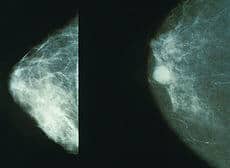Patients with early stage breast cancer who were treated with lumpectomy plus radiation may have a better chance of survival compared with those who underwent mastectomy, according to Duke Medicine research.
The study, which appears online Jan. 28, 2013, in the journal Cancer, raises new questions as to the comparative effectiveness of breast-conserving therapies such as lumpectomy, where only the tumor and surrounding tissue is surgically removed.
 “Our findings are observational but do suggest the possibility that women who were treated with less invasive surgery had improved survival compared to those treated with mastectomy for stage I or stage II breast cancer,” said E. Shelley Hwang, M.D., MPH, chief of breast surgery at Duke Cancer Institute and the study’s lead author.
“Our findings are observational but do suggest the possibility that women who were treated with less invasive surgery had improved survival compared to those treated with mastectomy for stage I or stage II breast cancer,” said E. Shelley Hwang, M.D., MPH, chief of breast surgery at Duke Cancer Institute and the study’s lead author.
Taking advantage of 14 years of data from the California Cancer Registry, a source of long-term outcome data for women diagnosed with and treated for breast cancer in California, the research team found improved survival to be associated with the less invasive treatment in all age groups, as well as those with both hormone-sensitive and hormone-resistant cancers. Women age 50 and older at diagnosis with hormone-sensitive tumors saw the largest benefit of choosing lumpectomy plus radiation: they were 13 percent less likely to die from breast cancer, and 19 percent less likely to die from any cause compared with those undergoing mastectomy.
Prior randomized trials have shown that when it comes to survival, lumpectomy with radiation is as effective as mastectomy in treating early stage breast cancer. As a result, the rate of women electing lumpectomy with radiation has climbed in the past few decades.
However, a recent trend has emerged with more early stage breast cancer patients, often younger women with very early cancers, opting for mastectomy. These women may perceive mastectomy to be more effective at eliminating early stage cancer and therefore reducing the anxiety accompanying long-term surveillance.
“Given the recent interest in mastectomy to treat early stage breast cancers despite the research supporting lumpectomy, our study sought to understand what was happening in the real world, how women receiving breast-conserving treatments were faring in the general population,” Hwang said.
The team analyzed data from 112,154 women diagnosed with stage I or stage II breast cancer between 1990 and 2004, including 61,771 who received lumpectomy and radiation and 50,383 who had mastectomy without radiation.
The researchers looked at age and other demographic factors, along with tumor type and size to decipher whether each treatment had better outcomes for certain groups of women. Patients were followed on average for 9.2 years.
The researchers evaluated whether illnesses other than breast cancer, such as heart and respiratory disease, may have influenced whether women chose lumpectomy or mastectomy. Within three years of diagnosis, breast cancer patients who underwent lumpectomy and radiation had higher survival rates than those who chose mastectomy when all other illnesses were evaluated. This suggests that women choosing lumpectomy may have been generally healthier.
However, Hwang and her colleagues were surprised to also find that early stage breast cancer patients treated with breast-conserving treatment had a significantly better short-term survival rate from breast cancer than women who underwent mastectomy. A subset analysis limited to women with stage I cancer only showed consistent results.
“The hopeful message is that lumpectomy plus radiation was an effective alternative to mastectomy for early stage disease, regardless of age or tumor type,” said Hwang. “Our study supports that even patients we thought might benefit less from localized treatment, like younger patients with hormone-resistant disease, can remain confident in lumpectomy as an equivalent and possibly better treatment option.”
The authors emphasize that observational studies such as this one cannot establish causality between type of surgery and outcome and that longer follow up is needed. Nevertheless, this is a provocative observation that requires more research to understand whether patient factors that were not available for analysis might contribute to these observed survival differences.
If our reporting has informed or inspired you, please consider making a donation. Every contribution, no matter the size, empowers us to continue delivering accurate, engaging, and trustworthy science and medical news. Independent journalism requires time, effort, and resources—your support ensures we can keep uncovering the stories that matter most to you.
Join us in making knowledge accessible and impactful. Thank you for standing with us!
